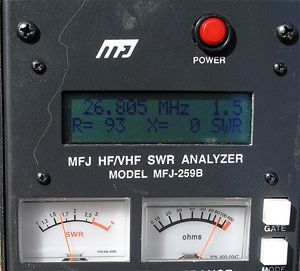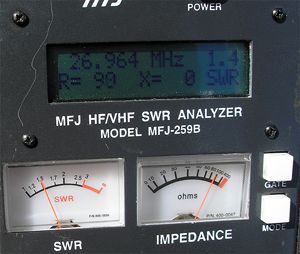Until I have a solid way of measuring/observing the differences between known stations it will be hard to answer all your questions.
I did not use the variable cap very long, and when I did I had it static. Rotating it away from fully open resulted in a severe mismatch.
Unless I come up with a smaller variable than I have, make one/buy one I won't rightly know.
What we see on the analyzer is still open for interpretation it seems.
To get the match down from around 1:3 to one to 1.0:1 on 27.405 I had to shorten the antenna 1-1/2". The new matching network and the radials may have contributed to this difference. What I'd have to do is remove the GP and see where the tune landed afterward compared to now.
The comparison to the antenna with the previous matching network has too many dissimilarities to be a reliable reference, IMNotSoHO.
I had a match previous to the GP with this network, however I didn't record it.
I have not read whether anyone retuned their antennas after the addition of the spiderplane, either so we have no point of reference to the effects of the spiderplane on the match. As for creating the swastika thing I could always hang a picture of Adolf Hitler in the shack and see if that will help. Just kidding. I could add wires to the ends of the radials at 90 degrees.
Homer, I assume you might be talking about my questions, but I'm not sure.
Are you telling us now that you don't have any previous signal test results to use in comparing your future real world results for this EFHW
?
Am I right or wrong, that your use of the variable cap did not work out to effectively control the match except in a static and open position
?
I think I recall you were impressed with a video of a guy using a variable cap to tune something, and maybe that gave you the idea to do that with this EFHW. But, are you telling us now that the cap you used did not work out as you expected, and the rotation of the fins had to be set wide apart in order to work at all, and it only worked a little bit when it was set and static in that open position
?
These are just some comments.
1. It would seem to me changing both the tuning device and adding the 12 x 36" radials in one step...would likely leave questions as to what did what, and I agree trying to compare results under such circumstances would be questionable, but you did get nearly...the same'O same'O, so no harm done.
2. I don't understand all the X=0 values either, just like NB suggested. But, I think it is clear that your analyzer shows us, that basically, no mater what you do to the antenna, radials or not, we don't see the effects of much change...in the match at least. Again, that is what my observations have been showing for a long time. However, I can't make anymore out this seeming fact, than maybe we see a bit less bandwidth with radials added, and maybe the bandwidth curve takes a more traditional bowl shape...when radials are attached.
3. Concerning the lack of whether others had to re-tune their EFHW after adding radials...whether spiderwave, original, or 1/4 wave should not be in dispute...if your results and mine are correct. IMO, according to both of our real world results...adding radials doesn't seem to present a problem that might require retuning of an EFHW if matched well to start.
4. I think Bob's design was using 3 radials that were maybe 72" radials from a Solarcon GPK, but I can't be sure. I think maybe they were using an all metal type EFHW, so unless he is willing to tell us the dimensions, I could only guess. I did a model once, and posted it to this forum, but I don't recall, when I asked him if it looked like his antenna...whether he ever confirmed or denied that the model of dimensions were similar to his project. I think they used wire and twine to help secure the added wire portion of the radials horizontally.
Homer, maybe this spiderplane idea is the missing link we haven't considered in seeing an EFHW that can produce a better gain pattern by 2-4 dbi, much less 2-4 Sunits like has been claimed. Honestly, I could never tell a difference in signals.


